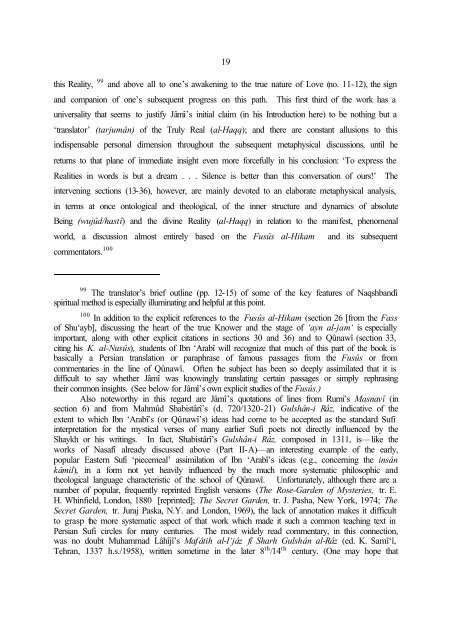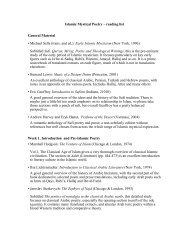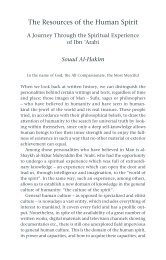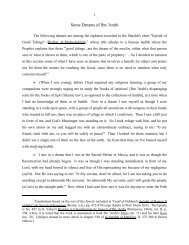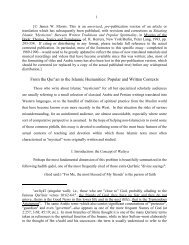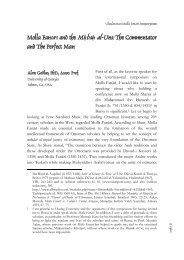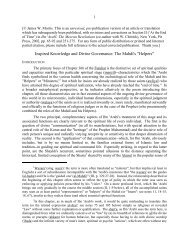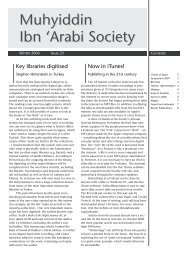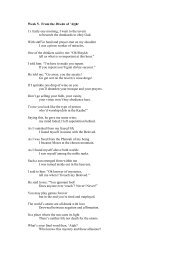Part III (pdf) - Muhyiddin Ibn Arabi Society
Part III (pdf) - Muhyiddin Ibn Arabi Society
Part III (pdf) - Muhyiddin Ibn Arabi Society
Create successful ePaper yourself
Turn your PDF publications into a flip-book with our unique Google optimized e-Paper software.
19this Reality, 99 and above all to one’s awakening to the true nature of Love (no. 11-12), the signand companion of one’s subsequent progress on this path. This first third of the work has auniversality that seems to justify Jâmî’s initial claim (in his Introduction here) to be nothing but a‘translator’ (tarjumân) of the Truly Real (al-Haqq); and there are constant allusions to thisindispensable personal dimension throughout the subsequent metaphysical discussions, until hereturns to that plane of immediate insight even more forcefully in his conclusion: ‘To express theRealities in words is but a dream . . . Silence is better than this conversation of ours!’ Theintervening sections (13-36), however, are mainly devoted to an elaborate metaphysical analysis,in terms at once ontological and theological, of the inner structure and dynamics of absoluteBeing (wujûd/hastî) and the divine Reality (al-Haqq) in relation to the manifest, phenomenalworld, a discussion almost entirely based on the Fusûs al-Hikam and its subsequentcommentators. 10099 The translator’s brief outline (pp. 12-15) of some of the key features of Naqshbandîspiritual method is especially illuminating and helpful at this point.100 In addition to the explicit references to the Fusûs al-Hikam (section 26 [from the Fassof Shu‘ayb], discussing the heart of the true Knower and the stage of ‘ayn al-jam‘ is especiallyimportant, along with other explicit citations in sections 30 and 36) and to Qûnawî (section 33,citing his K. al-Nusûs), students of <strong>Ibn</strong> ‘Arabî will recognize that much of this part of the book isbasically a Persian translation or paraphrase of famous passages from the Fusûs or fromcommentaries in the line of Qûnawî. Often the subject has been so deeply assimilated that it isdifficult to say whether Jâmî was knowingly translating certain passages or simply rephrasingtheir common insights. (See below for Jâmî’s own explicit studies of the Fusûs.)Also noteworthy in this regard are Jâmî’s quotations of lines from Rumi’s Masnavî (insection 6) and from Mahmûd Shabistârî’s (d. 720/1320-21) Gulshân-i Râz, indicative of theextent to which <strong>Ibn</strong> ‘Arabî’s (or Qûnawî’s) ideas had come to be accepted as the standard Sufiinterpretation for the mystical verses of many earlier Sufi poets not directly influenced by theShaykh or his writings. In fact, Shabistârî’s Gulshân-i Râz, composed in 1311, is—like theworks of Nasafî already discussed above (<strong>Part</strong> II-A)—an interesting example of the early,popular Eastern Sufi ‘piecemeal’ assimilation of <strong>Ibn</strong> ‘Arabî’s ideas (e.g., concerning the insânkâmil), in a form not yet heavily influenced by the much more systematic philosophic andtheological language characteristic of the school of Qûnawî. Unfortunately, although there are anumber of popular, frequently reprinted English versions (The Rose-Garden of Mysteries, tr. E.H. Whinfield, London, 1880 [reprinted]; The Secret Garden, tr. J. Pasha, New York, 1974; TheSecret Garden, tr. Juraj Paska, N.Y. and London, 1969), the lack of annotation makes it difficultto grasp the more systematic aspect of that work which made it such a common teaching text inPersian Sufi circles for many centuries. The most widely read commentary, in this connection,was no doubt Muhammad Lâhîjî’s Maf âtih al-I‘jâz fî Sharh Gulshân al-Râz (ed. K. Samî‘î,Tehran, 1337 h.s./1958), written sometime in the later 8 th /14 th century. (One may hope that


